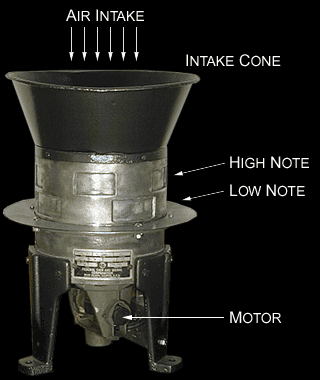|
How Sirens Work

An electro-mechanical siren is a fairly simple device. It consists of an electric motor which turns a fan called the "rotor" or "impeller", spinning inside a slotted drum called the "stator".
The first job of the rotor is as a centrifugal fan. It pulls air into the siren axially through the intake, and blows it out radially through the holes in the stator. The second job of the rotor is to chop the incoming air stream into impulsive bursts. The rotor is segmented by vanes that periodically cover and uncover the holes in the stator. Each time the rotor and stator holes align, a burst of air is forced through. The frequency of these bursts is the pitch of the siren.
The siren in the diagram to the right is my dual-tone Model 2. To create two distinct tones, this siren has a two-level rotor and stator assembly. The top half of the rotor has 5 vanes, and the bottom half has only four.
Side note: The above siren animation is way slowed down. In actual use, it spins at over 7000 rpm. No wonder Federal puts those big DANGER OF AMPUTATION! signs on these things!
Article Source: http://www.airraidsirens.com/
|